
Tips voor video-opnamen, productie, videobewerking en onderhoud van apparatuur.

Tips voor video-opnamen, productie, videobewerking en onderhoud van apparatuur.
Als je wilt beginnen met het opnemen of mixen van muziek en niet zeker weet welke apparatuur je nodig hebt, ben je hier aan het juiste adres. We helpen je bij het kiezen van de beste audio-opnameapparatuur die past bij je vaardigheden, muziek en budget. Of u nu op zoek bent naar een audio-interface, microfoons, studiomonitors of meer, wij helpen u bij het uitbouwen van uw thuisstudio met alle apparatuur die u nodig hebt om vandaag nog te kunnen opnemen.
Welke soorten opnamen heb je gepland?
Een recorder kiezen
Een audio-interface voor een computer kiezen
Software kiezen
Opnamemicrofoons kiezen
Audiomonitors kiezen
Audiomonitors kiezen Koptelefoon
Effecten/signaalprocessors kiezen
Opnameaccessoires kiezen
Woordenlijst met opnametermen
Bent u op zoek naar een opname-apparatuur of misschien een complete opname-opstelling, maar vindt u het moeilijk om te beslissen wat u moet kopen? Nou, je zoektocht stopt hier.
Onze gids laat je kennismaken met de basisuitrusting en terminologie van het opnemen van muziek en helpt je de keuzes te maken die bij je passen.
Er zijn een paar uitrustingen die elke muzikant die geïnteresseerd is in opnemen nodig heeft, en als je het uit elkaar haalt, is het vrij eenvoudig. Kortom, je hebt iets nodig om je muziek op te nemen en te bewerken, een manier om te luisteren naar wat je hebt opgenomen en een manier om je opnamen te delen.
Afgezien van deze basisprincipes, is de uitrusting die je nodig hebt specifiek gebaseerd op het type opnamen dat je gaat maken.
Als je diepgaande informatie over opnemen nodig hebt, van de basis tot geavanceerde onderwerpen, zijn de vele handige boeken en video's over opnemen die we verkopen een geweldige plek om je kennis uit te breiden.
De sleutel tot het kiezen van je uitrusting is om je te concentreren op de soorten projecten die je hebt gepland, en vervolgens de apparatuur te selecteren met de kenmerken en functies die je nodig hebt.
Laten we beginnen met het uitsplitsen van de soorten apparatuur die u nodig heeft op basis van de soorten muziek waaraan u gaat werken. Houd deze vraag in gedachten als je leest en nadenkt over apparatuur:welke functies heb ik nodig op basis van de soorten opnamen die ik wil maken?
Als je aan een klein solo- of duoproject werkt, zijn je behoeften misschien vrij eenvoudig. Of u nu kiest voor een computergebaseerd opnamesysteem of een stand-alone meersporenrecorder, u hebt twee tot vier sporen met gelijktijdige opnamecapaciteit nodig, ten minste één microfoon en een hoofdtelefoon en/of studiomonitors voor afspelen en overdubben. Je zult ook de juiste kabels willen hebben om je apparatuur aan te sluiten en waarschijnlijk een microfoonstandaard of twee.
Je hebt voldoende inputs nodig om al je zang- en instrumentmicrofoons aan te kunnen, evenals inputs voor elektronische instrumenten zoals een elektrische gitaar, bas of keyboard. Uw computer opnamesoftware of multitrack recorder kan ingebouwde effecten hebben, maar u wilt misschien ook een externe signaalprocessor. Daarover later meer.
Voor het opnemen van solo- of duo-optredens is een audio-interface met een of meer microfoonvoorversterkers wellicht alles wat u nodig hebt om uw computer of zelfstandige opnameapparatuur aan te sluiten.
Samen met zijn veelgeprezen microfoonvoorversterkers en 24-bit/192kHz-definitie, biedt de Focusrite Scarlett 2i2 USB Audio-interface bevat functies om het het hart van uw mobiele opname-installatie te maken.
Voor het opnemen van een groep wil je een recorder met vier tot 16 kanalen of meer voor gelijktijdige opname, een selectie van verschillende microfoons, studiomonitors en koptelefoons voor afspelen en overdubben; de juiste kabels en aansluitingen om alles aan te sluiten; sommige microfoonstandaards; een of meer speciale microfoonvoorversterkers en een of twee compressor- of opnamekanalen voor gebruik op zang en solo-instrumenten, vooral akoestische instrumenten.
Dit zou genoeg moeten zijn om de hele band op te nemen, afhankelijk van het aantal microfoons en ingangen die je gebruikt voor de verschillende instrumenten en zang. Mogelijk hebt u een mixer nodig met 12 kanalen of meer en meerdere bussen, afhankelijk van de ingangen en mixmogelijkheden van uw audio-interface of recorder. Houd er rekening mee dat een volledige drumkit op zichzelf al vijf of meer microfoons en microfooningangen nodig heeft. Misschien wilt u ook wat extra verwerkingsopties, zoals speciale computersoftware-effecten of een externe signaalprocessor of twee.
En natuurlijk, als je eenmaal de basis hebt ingesteld, kun je ook uitbreiden naar een aantal opnamegerelateerde accessoires, zoals directe boxen voor het rechtstreeks opnemen van instrumenten zoals elektrische gitaren, basgitaren en keyboards in je recorder. Andere accessoires zoals popfilters, studioschuim, monitorstandaards, rekken en opnamemeubels om de zaken op orde te houden en de kwaliteit van het opgenomen geluid te verfijnen.
Zoals je waarschijnlijk al hebt gerealiseerd, kan het samenstellen van een opname-installatie een uitdaging zijn. Bij Musician's Friend bieden we een enorme selectie aan opnamepakketten met zorgvuldig gekozen componenten waarmee je met een minimum aan gedoe aan de slag kunt. Deze pakketten bieden ook grote waarde, omdat hun prijzen besparingen opleveren ten opzichte van het kopen van de afzonderlijke componenten.
Is opnemen meer dan een hobby voor je? Als je een ruimte hebt die speciaal is ingericht voor opnames en je werkt aan projecten op professioneel niveau, zou je een hardware-multitrackrecorder, een computergebaseerde audio-interface en/of DAW-software moeten overwegen die 16 of meer tracks levert. gelijktijdige opname.
Projectstudio's op professioneel niveau zouden een aantal monitoren en een selectie koptelefoons moeten hebben voor kritisch luisteren. Je hebt ook een gevarieerde verzameling microfoons nodig, waaronder dynamische microfoons en lint- en condensatormicrofoons voor de meeste zang, instrumenten en situaties. Een reeks signaalprocessors zoals microfoonvoorversterkers, opnamecompressoren en -begrenzers, kanaalstrips, equalizers en effectprocessors voegen veelzijdigheid toe aan uw gereedschapskist en polijsten uw producties. Als je de voorkeur geeft aan het hands-on gevoel van echte faders en knoppen, overweeg dan een hoogwaardige opnamemixer met 24 kanalen of meer, en met vier of meer bussen en mixgroepen naast de main outs.

Met veel IO, 8 microfoonvoorversterkers en superlage latentie, biedt het Apogee Ensemble Thunderbolt 2 Audio Interface is een uitstekende keuze voor projectstudio's.
Denk ook aan de ruimte waarin u opneemt. Correct gebruik van akoestisch schuim en andere akoestische behandelingsmaterialen zal u helpen ongewenste echo's en resonanties in de studio te temmen en de kwaliteit van uw opnames te verbeteren. Je hoort ook nauwkeuriger in een akoestisch behandelde ruimte, wat kan leiden tot betere mixen.
Naarmate uw opname-instelling groter wordt, wordt het ingewikkelder en heeft het baat bij enige organisatie. Accessoires zoals monitorstandaards, monitorisolatiepads, meerkanaals hoofdtelefoonversterkers, direct boxes en popfilters kunnen zich opstapelen. Studiomeubels moeten helpen om je opstelling op orde te houden.
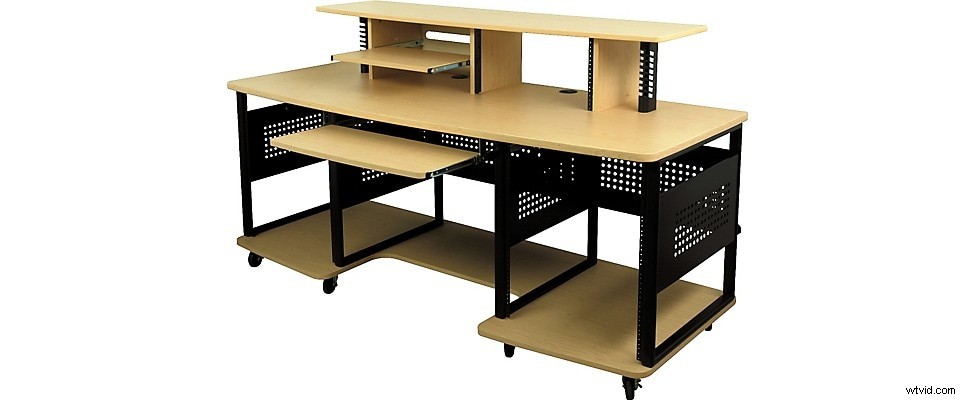
Het Studio RTA Producer Station biedt een ergonomisch ontworpen werkruimte die opslagruimte en rekruimte biedt om netjes in op te bergen alle componenten van een typische projectstudio.
Je hebt een aantal opties voor hoe je het opnemen van audio benadert, en elk heeft zijn eigen voordelen. Voor velen is een computergebaseerde opname-instelling met audiosoftware de meest veelzijdige en handige oplossing. Anderen houden van de fysieke controle die hardware biedt. We zullen deze verschillende benaderingen bekijken en u door de koopoverwegingen voor elk leiden.
Tegenwoordig worden de meeste thuisopnames gemaakt met een computer of iOS-apparaat in plaats van op hardware gebaseerde opnameconsoles of tafelrecorders. Digital Audio Workstation (DAW)-software biedt functies en mogelijkheden die anders vrij duur zouden zijn in een hardwaregebaseerde installatie.
Nu hebt u waarschijnlijk al een desktop- of laptopcomputer die u voor uw opnamen hebt willen gebruiken. Houd echter rekening met enkele specificaties die belangrijk zijn om te bepalen of uw computer de taak aankan.
De centrale verwerkingseenheid (CPU) van de computer is het onderdeel dat instructies verwerkt die door uw computerprogramma's zijn verzonden. Hoe snel en efficiënt een computer dit kan doen, wordt bepaald door de kloksnelheid (gemeten in GHz) en het aantal verwerkingskernen. Aangezien je een aantal randapparatuur gaat aansluiten en meerdere tracks op elkaar gaat stapelen, is het belangrijk om over voldoende verwerkingskracht te beschikken.
Random Access Memory (RAM) is een type geheugen dat programma's gebruiken om audioverwerkingstaken uit te voeren. Audiosoftware en de apparaten die u op uw audiowerkstation aansluit, hebben doorgaans veel van dit type geheugen nodig, dus meer is beter. Om je opname-instellingen soepel te laten verlopen, heb je een computer nodig met minimaal 16 GB RAM, en bij voorkeur meer voor complexe opnamen. Zoek naar een computer die veel RAM-uitbreidingsmogelijkheden biedt.
De audiobestanden die u gaat maken, zijn vrij groot en nemen ongeveer 800 MB per 80 minuten opgenomen audio in beslag bij het opnemen met de cd-standaard van 44,1 kHz/16-bit. Om dit allemaal op te slaan, wil je een harde schijf met minimaal 1 TB opslagruimte. U kunt ook snelle externe harde schijven aanschaffen die zijn ontworpen om goed samen te werken met uw audiobestanden.

De Glyph StudioRAID mini biedt compacte en betrouwbare externe opslag van uw audiobestanden met capaciteiten variërend van 1 –4TB.
Beslissen of je voor een Mac of pc gaat, is een beetje anders voor audio-opname dan voor ander computergebruik. Hoewel een Windows-pc zeker in staat is om de taken uit te voeren die u moet uitvoeren, zult u merken dat Mac de industriestandaard is geworden en de voorkeur heeft van veel muzikanten en opnametechnici.
De reden hiervoor is dat Mac een sterke staat van dienst heeft op het gebied van betrouwbaarheid en stabiliteit, mede dankzij de strikt gecontroleerde ontwerpen en toepassingsnormen. Bovendien voelen veel professionals zich aangetrokken tot Mac-exclusieve hardware- en softwareproducten vanwege hun uitstekende integratie met Apple-producten.
Dat gezegd hebbende, veel applicaties en USB-audio-interfaces zijn compatibel met zowel pc's als Macs.
Hoewel computeropname de dag kan beheersen, zijn er nog steeds voordelen aan speciale hardware voor opnemen, en een van de belangrijkste is draagbaarheid. Houd er rekening mee dat als je van plan bent om veel onderweg op te nemen, in plaats van voornamelijk op één locatie, je misschien hardware nodig hebt die audio kan opnemen zonder een aangesloten computer.
Een optie die zowel draagbaar als veelzijdig is, is het kopen van opnamehardware die kan fungeren als een USB-audio-interface wanneer u deze met uw computer gebruikt. Je zult veel interfaces vinden met deze mogelijkheid.

De zeer draagbare Zoom R16 Multitrack Recorder/Interface neemt op op SDHC-kaarten tot 32GB, heeft 8 gebalanceerde XLR/1/4-inch ingangen, meer dan 100 effecten van studiokwaliteit en werkt met de meeste DAW-software.
Een alternatieve benadering van mobiel opnemen die uitstekende resultaten kan opleveren, is om uw iPad of iPhone te gebruiken met randapparatuur die voor deze taak is ontworpen. Op de Musician's Friend-site vindt u een aantal mobiele opname-opties waarmee u uw iOS-apparaat onderweg in een miniatuuropnamestudio kunt veranderen. Met honderden opname-, mastering- en effect-apps om uit te kiezen, is de hemel de limiet in termen van op iOS gebaseerde opnamemogelijkheden.
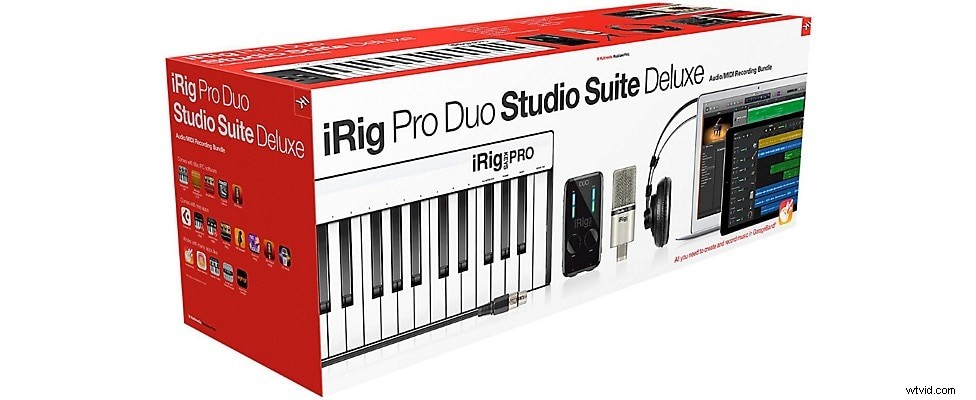
De iRig Pro Duo Studio Suite Deluxe van IK Multimedia wordt geleverd met alle hardware die je nodig hebt om geweldig iOS te produceren opnames. Sterker nog, het is compatibel met Mac/pc en Android.
De snelle ontwikkeling van muzikantvriendelijke apps op het iOS-platform heeft geleid tot de introductie van veel iOS-apparatuur. Tegenwoordig kan je iPhone of iPad worden omgevormd tot het commandocentrum voor al je audioproducties. Het gebruik van de iOS-bewuste microfoons, mixers, interfaces en controllers in de Musician's Friend iOS Store is een zeer draagbare en betaalbare manier om je muziekproductievaardigheden te ontwikkelen en tegelijkertijd projecten te creëren die kunnen wedijveren met professioneel werk.
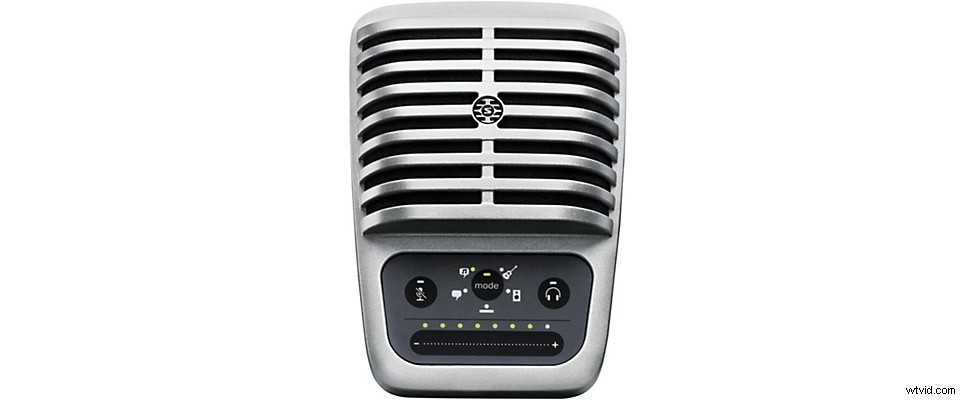
De Shure Motiv MV51 grootdiafragma condensatormicrofoon maakt rechtstreeks verbinding met uw met Lightning uitgeruste mobiele apparaten plus Mac en pc's en produceert verbluffend gedetailleerde opnamen met eenvoud van plug 'n' play.
Als u ervoor kiest om voor uw opname speciale hardware te gebruiken in plaats van een computergebaseerd systeem, zijn er een aantal opties. Een van hun grootste voordelen zijn speciale fysieke knoppen, knoppen en faders die veel gemakkelijker te gebruiken zijn dan door de vaak complexe meerlaagse menu's van computergebaseerde software te bladeren.
Let bij het kiezen van een multitrackrecorder op hoeveel tracks u krijgt:audio, MIDI, actueel en virtueel, en hoeveel u tegelijkertijd kunt opnemen en afspelen. Alle, behalve de meest elementaire multi-trackers, zouden je enkele bewerkings- en mixfuncties moeten bieden om je opnamen op te poetsen.
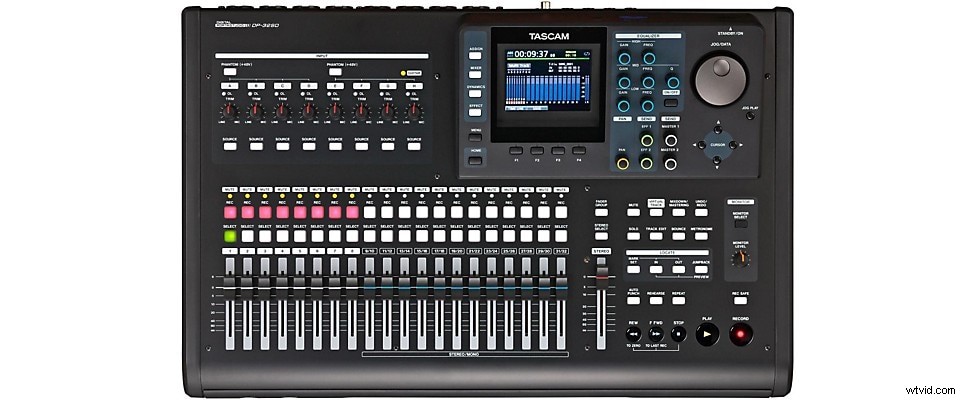
Een geweldige optie om door softwaremenu's te waden, de Tascam DP-32SD Portastudio biedt echte hands- op controle van alle belangrijke functies en tot 32 tracks gelijktijdig afspelen.
Terwijl je door de selectie bladert en de banden schopt, zijn hier enkele aanvullende specificaties om op te letten:
Het aantal en type inputs en outputs moet een belangrijk aandachtspunt zijn. Je hebt voldoende ingangen nodig om alles aan te sluiten op alle verbindingstypes die je wilt gebruiken. Onder de opties voor verbindingstypes ziet u gebalanceerd, ongebalanceerd, fantoomvoeding voor condensatormicrofoons, XLR, 1/4", TRS, MIDI, Hi-Z, surround sound, RCA, S/PDIF, wordclock, ADAT en AES/EBU om uw apparatuur aan te sluiten. De meeste recorders hebben ook USB-, FireWire- of Thunderbolt-poorten voor computerconnectiviteit.
Maak een inventaris van de microfoons, instrumenten en andere apparatuur die u wilt aansluiten en begrijp de soorten verbindingen die ze gebruiken. Op deze manier weet je naar wat voor soort specificaties je moet zoeken tussen de vele beschikbare opties.
Zorg ervoor dat u de specificaties voor de bemonsteringsfrequentie en bitsnelheid controleert, verwerkt door de analoog-naar-digitaal (A/D) omzetter. Over het algemeen geldt:hoe hoger het getal, hoe hoger de geluidskwaliteit, waarbij 16-bit/44,1 kHz de standaard is voor cd's en 24-bit-converters de standaard voor professionele opnames. Hogere bemonsteringsfrequenties bieden meer hoofdruimte en respons op hoge frequenties - belangrijke audiofactoren voor professionele opnamen.
Bestudeer de mixersectie om te zien welk type en kwaliteit van de controles u krijgt. Zoek naar meters, faders, knoppen, EQ en sends. Als het geen mixersectie heeft, moet je een mixer kopen.
Multitrackers nemen intern op op flashgeheugen of op een harde schijf, en sommige laten je opnemen op een extern opslagapparaat of de opslag upgraden met een groter opslagapparaat. Multitrack-audio kan veel opslagruimte in beslag nemen, dus houd daar rekening mee.
Enkele van de functies die uw opname-opties kunnen vergroten, zijn zaken als een interne MIDI-sequencer, modules die instrumentgeluiden genereren, een ingebouwde effectprocessor, een aparte mastering-sectie en een ingebouwde cd-brander. Je moet ook nadenken over hoe intuïtief het is ingedeeld en hoe gemakkelijk het te gebruiken is.
Als uw opnamebehoeften eenvoudig zijn, bijvoorbeeld als u een hulpmiddel wilt voor het opnemen van oefensessies of podcasts, kunt u een draagbare handheld of veldrecorder overwegen.
Meestal bevatten deze kleine apparaten een paar condensatormicrofoons voor kwaliteitsopnamen, en ze nemen audio op op een verwisselbare flashdrive, zodat u de bestanden gemakkelijk naar uw computer kunt overbrengen of op cd kunt branden.

De Zoom H6 Handy Recorder heeft een paar hoogwaardige condensatormicrofoons met verwisselbare capsules en geavanceerde voorversterkers voor een uitstekende opnamekwaliteit in vrijwel elke omgeving.
Als je kiest voor de computergebaseerde benadering van opnemen, heb je een audio-interface nodig om alles op je computer aan te sluiten. Dit apparaat geeft je niet alleen een plek om alles in te pluggen, het vervult ook de cruciale rol van het converteren van analoge audiosignalen naar digitaal met behulp van een analoog naar digitaal (A/D) converter. Het zet ook het digitale signaal van uw computer terug in een analoog signaal met behulp van een digitaal-naar-analoog-omzetter (D/A) voor weergave via uw monitorluidsprekers en/of hoofdtelefoon.
Door uw audiosignalen om te zetten van analoog naar digitaal, voert uw interface een gespecialiseerde taak uit die uw computer ontlast. Met een goede interface betekent dit dat je geluiden kunt maken en ernaar kunt luisteren terwijl ze bijna in realtime worden afgespeeld, zonder de latentie die het opnameproces bemoeilijkt. Zoek naar een interface die is uitgerust met hoogwaardige A/D- en D/A-converters die uw geluid nauwkeurig vertalen van het analoge naar het digitale rijk en weer terug. (Zie het gedeelte Audiokwaliteit hieronder voor informatie over het vergelijken van de specificaties van de converter.)
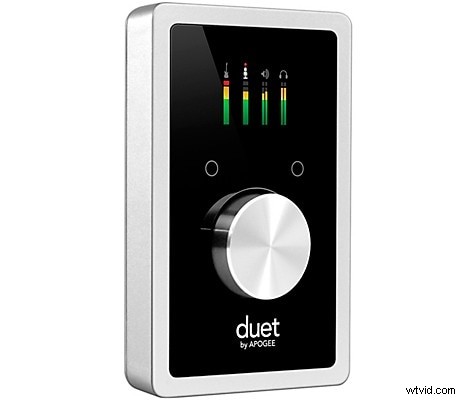
De Apogee Duet voor Mac en iOS werkt met uw Mac of iPad met behulp van hoogwaardige converters en dubbele microfoonvoorversterkers om uw muziek nauwkeurig vast te leggen en om te zetten voor opname en bewerking op de computer.
Wanneer u op zoek bent naar een audio-interface voor een computer, is het essentieel om erachter te komen of deze met uw computer zal werken. Twee dingen die u moet controleren, zijn:hoe het verbinding maakt met uw computer en de systeemvereisten van de fabrikant voor de interface. De belangrijkste verbindingstypen zijn USB, FireWire of Thunderbolt. Bekijk de processor-, geheugen- en verbindingsvereisten om de compatibiliteit met uw computer te bevestigen.
Universal Audio's Apollo X-audio-interfaces bieden opname en monitoring van studiokwaliteit in combinatie met on-board DSP voor het aandrijven van hun UAD plug-in platform.
Ook van belang moet het aantal en type audio-ingangen en -uitgangen zijn:gebalanceerd, ongebalanceerd, fantoomvoeding, XLR, 1/4", TRS, MIDI, Hi-Z, surround sound, RCA, S/PDIF, wordclock, ADAT en AES/EBU. Let op hoeveel audiokanalen er tegelijkertijd worden opgenomen en afgespeeld.
Sommige computerinterfaces bevatten hardwarebesturingen, sommige hebben softwarebesturingen en sommige hebben beide. Ze bevatten ook vaak mixersoftware om de routering van de I/O- en niveaumeters af te handelen.
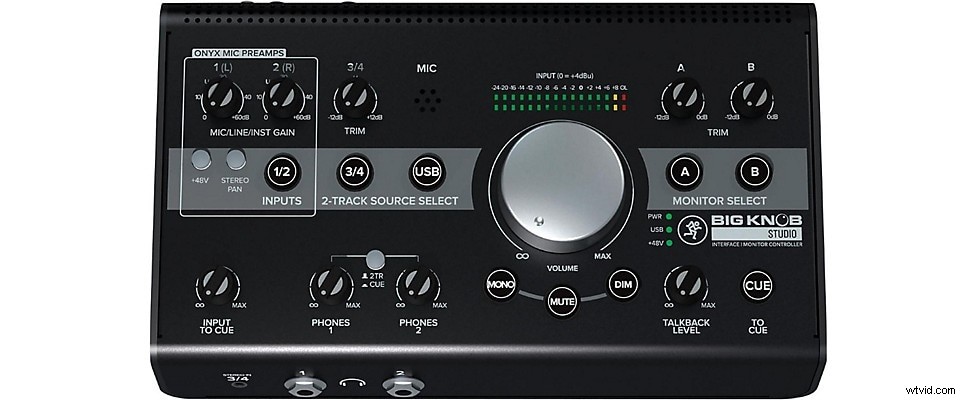
De Mackie Big Knob Studio Monitor Controller Interface beschikt over dubbele Onyx-voorversterkers, tot 192 kHz/24- bit opnemen en afspelen en biedt tal van controlemogelijkheden.
Controleer de specificaties voor de bemonsteringsfrequentie en bitsnelheid die worden aangeboden door de analoog-naar-digitaalomzetter. Over het algemeen geldt:hoe hoger het getal, hoe hoger de geluidskwaliteit, waarbij 16-bit/44,1 kHz de standaard is voor cd's en 24-bit-converters de standaard voor professionele opnames. Hogere bemonsteringsfrequenties bieden meer hoofdruimte en hoogfrequente respons bij digitale opnamen - belangrijke factoren voor professioneel klinkende opnamen.
Alle computer audio-interfaces hebben enige latentie of vertraging, maar zeer goede hebben zo weinig dat je het niet merkt. De meeste goede computeraudio-interfaces bieden een manier om latentie te meten en te regelen. Sommige bieden een tijdelijke oplossing, zoals hardwaresignaalbewaking. Een interface met te veel latentie maakt het bijna onmogelijk om normale multitrack-bewerkingen uit te voeren, zoals overdubben of realtime monitoring. Een langzamere computer draagt bij aan latentie.
Leer meer over het kiezen van de juiste computerinterfaces met onze deskundige koopgids voor audio-interfaces.
Zonder audiosoftware zouden computers niet de krachtpatsers voor muziekproductie zijn die ze nu zijn. En er zijn tal van software-opties die uw audioproductie van begin tot eind kunnen afhandelen:opnemen, mixen, bewerken, masteren, dupliceren en in sommige gevallen zelfs songwriting.
Een industriestandaard softwarepakket dat u in de meeste moderne opnamestudio's zult zien, is Avid's Pro Tools. Met veel professionele functies en plug-ins is Pro Tools een uitstekende keuze voor diegenen die op zoek zijn naar de best mogelijke audiokwaliteit en bijna onbeperkte geluidsverwerkingsopties. Pro Tools is echter een relatief complex programma voor beginnende gebruikers en kent een steile leercurve.
Voor degenen die op zoek zijn naar veel tools om muziek te maken, naast het opnemen en bewerken ervan, is Propellerhead's Reason een zeer populaire keuze. Met een sequencer boordevol synths, samplers en andere tools voor het maken van muziek, is het gemakkelijk om muziek van begin tot eind te produceren. Er is een Reason-versie die past bij de meeste behoeften en budgetten.
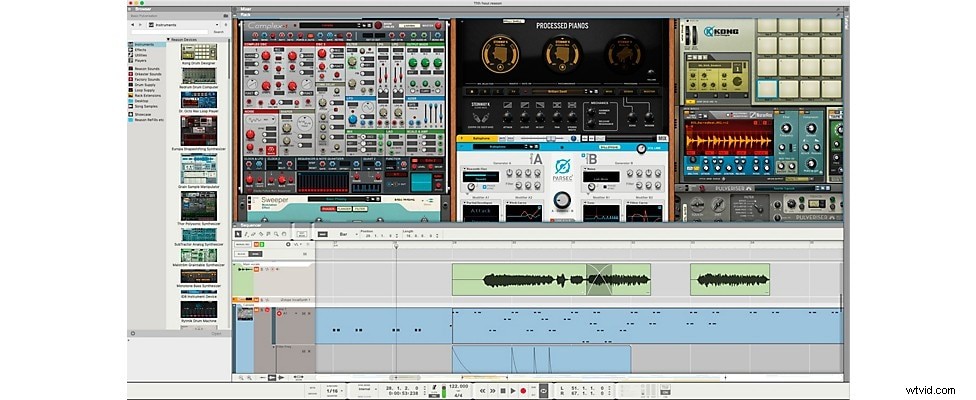
Reason is een favoriet onder producenten dankzij de enorme set drums, synths en verpakte effecten up in een intuïtieve DAW-interface.
We hebben zojuist enkele van de meest populaire toepassingen voor audioproductie besproken. Ontdek onze enorme selectie van muzieksoftware voor meer geweldige keuzes.
Om je muziek in je opname-opstelling te krijgen, heb je ten minste één goede microfoon nodig, en waarschijnlijk meerdere. De belangrijkste typen om te overwegen zijn condensator-, dynamische en lintmicrofoons. Elk type heeft verschillende geluidskenmerken en wordt gebruikt voor opname in verschillende situaties.
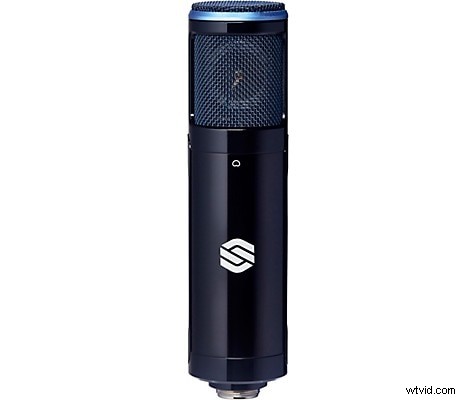
De grootmembraan Sterling Audio ST151 grootmembraan condensatormicrofoon is zeer bescheiden geprijsd, maar zeer gedetailleerd geluid van stemmen en instrumenten.
Lees meer in onze Koopgids voor microfoons.
Luisteren naar het afspelen is een belangrijk onderdeel van het opnameproces, en je moet er zeker van zijn dat je de juiste luidsprekers hebt om de klus te klaren. Hier zullen we nader bekijken wat een goede set studiomonitors is en enkele concepten behandelen waarmee u rekening moet houden bij het maken van uw keuze.
Studiomonitors zijn essentieel voor goede opnames. Bedoeld om u een nauwkeurig beeld te geven van de audio die u opneemt, overdubben, mixen, bewerken en masteren, ze zijn uw eerste verdediging tegen slecht geluid. De meeste monitoren die tegenwoordig worden gebruikt voor opnames in huizen en studio's zijn near-field-monitoren. Een near-field-monitor is klein genoeg om het geluid dat er rechtstreeks uit komt te horen, niet dat het geluid weerkaatst door de studiomuren. Kijk bij het overwegen van monitoren naar de frequentierespons en THD-specificaties om een idee te krijgen van de nauwkeurigheid van de monitor.
De grootte van de tweeter en de hoofddriver hebben ook invloed op hoe nauwkeurig een luidspreker audio kan reproduceren, aangezien grotere drivers de lage frequenties nauwkeuriger kunnen weergeven.
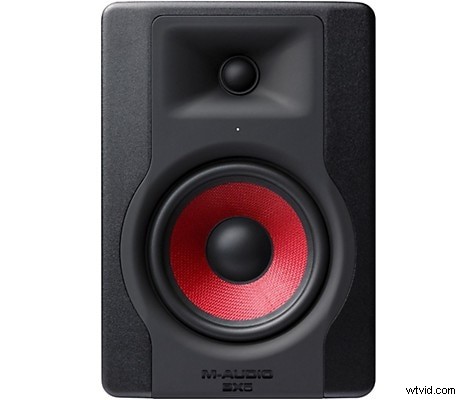
De M-Audio BX5 is een vertrouwde monitor in talloze thuisstudio's vanwege de vlakke frequentierespons en nauwkeurig stereobeeld.
Voor aansluitingen hebben monitoren meestal 1/4”, XLR-, RCA- of S/PDIF-aansluitingen. Sommige bieden alleen ongebalanceerde of gebalanceerde I/O, en sommige hebben beide.
Actieve monitoren, ook wel powered monitoren genoemd, hebben een of meer eindversterkers ingebouwd in de kast, en ze zijn vaak dubbel versterkt, met behulp van afzonderlijke versterkers die zijn afgestemd op elke driver voor optimale prestaties.
Passieve monitoren, ook wel niet-aangedreven monitoren genoemd, gebruiken een aparte, externe eindversterker die u enige flexibiliteit geeft bij het kiezen van uw componenten en het opzetten van arrays met meerdere luidsprekers. Passieve monitoren hebben meestal een crossover-circuit van hoge kwaliteit voor een uiterst nauwkeurige splitsing van hoge en lage frequenties.
Geavanceerde functies op monitoren zijn onder meer EQ-regelaars, akoestische ruimtecompensatie-effecten, balansregelaars en filters.
Als u beat- en bas-zware muziek of tv- en filmsoundtrackmateriaal opneemt, zal een subwoofer of surroundopstelling handig zijn bij het bewaken van de uitgebreide lage frequenties en extra kanalen die nodig zijn in dat soort muziek.
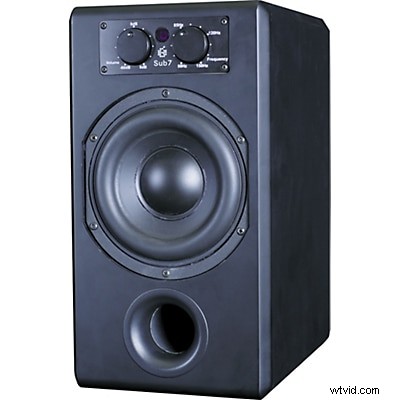
De ADAM Audio Sub7 heeft een compact formaat, maar kan frequenties tot 50 Hz reproduceren. Gemotoriseerde bedieningselementen maken eenvoudige frequentieaanpassingen en draadloze afstandsbediening mogelijk.
Naast uw monitoren, wilt u misschien enkele consumentenluidsprekers van behoorlijke kwaliteit toevoegen om een idee te krijgen van hoe uw opname zal klinken op consumentenapparaten. Als je luidsprekers nodig hebt die voor die taak zijn ontworpen, kijk dan eens naar de Musician's Friend-selectie van audio-afspeelapparatuur.
Luisteren met een koptelefoon voor de consumentenmarkt kan je ook waardevol inzicht geven over hoe je mix zal klinken op koptelefoons die zijn ingesproken voor het luisterplezier van de gemiddelde muziekliefhebber in plaats van 100% nauwkeurig geluid zoals dagelijkse opname- en mixkoptelefoons vereisen.
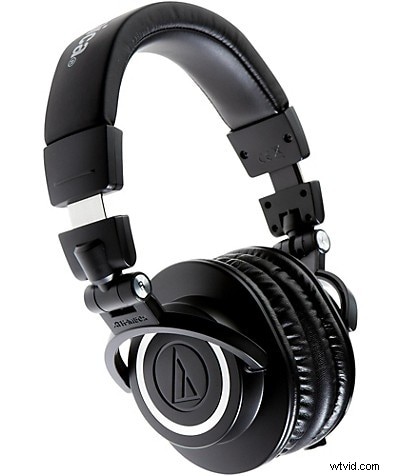
Audio-Technica's ATH-M50x hoofdtelefoon is een uitstekende keuze voor studio hoofdtelefoons. Deze hoofdtelefoon biedt niet alleen geluid van studiokwaliteit, maar is ook ongelooflijk populair op de consumentenmarkt, waardoor ze een perfecte keuze zijn om je mixen op te beluisteren.
Hoofdtelefoons worden over het algemeen gebruikt voor monitoring tijdens opnemen en overdubben, maar hoogwaardige hoofdtelefoons kunnen voor bijna alles worden gebruikt, inclusief kritisch luisteren en mixen. Kijk bij het overwegen van een koptelefoon naar de frequentierespons en THD-specificaties om een idee te krijgen van hun nauwkeurigheid. De grootte van de driver is ook van invloed op hoe nauwkeurig een luidspreker audio kan reproduceren, aangezien grotere drivers de lage frequenties nauwkeuriger kunnen weergeven. Zorg ervoor dat u voor het opnemen ten minste één hoofdtelefoon met gesloten achterkant hebt, die een betere akoestische isolatie heeft dan modellen met een open achterkant. Dit ontwerp voorkomt dat het geluid van de hoofdtelefoon in de microfoons "bloedt". Luisteren met een hoofdtelefoon voor de consumentenmarkt kan u ook waardevol inzicht geven over hoe uw mix zal klinken op hoofdtelefoons die EQd zijn voor aangenaam in plaats van nauwkeurig geluid.
Hoofdtelefoons gebruiken ofwel een 1/8"-aansluiting of een stereo 1/4"-aansluiting, en worden meestal geleverd met een adapter voor het gemak bij het aansluiten op apparatuur die de ene wel heeft, maar de andere niet.
Signaalprocessors omvatten alles, van eenheden die een enkel effect produceren tot multi-effectprocessors die honderden kunnen produceren. Bepaalde typen signaalprocessors, zoals compressoren, voorversterkers, equalizers, noise gates en limiters, dienen één enkel specifiek doel met variërende hoeveelheden kwaliteit en controle. Andere effecten, zoals reverbs, delays en enhancers/exciters, kunnen één enkel effect produceren, maar met veel variaties. Multi-effectprocessors bevatten veel verschillende effecten en variaties van die effecten. De belangrijkste kenmerken waarmee u rekening moet houden bij het kiezen van een signaalprocessor, is of deze het type effecten en de geluidskwaliteit produceert die u zoekt.
De meeste signaalprocessors bieden 1/4”, TRS- of XLR-aansluitingen, hoewel sommige ook RCA, S/PDIF, ADAT, wordclock en AES/EBU hebben.
Effectprocessors kunnen hardware- of softwarematig zijn. Hardwareprocessors zijn verkrijgbaar in desktop-, rackmount- en voetgestuurde units, waarbij rackmount de meest voorkomende is. Software-effecten worden net als elk ander softwareprogramma op uw computer geïnstalleerd en kunnen worden gebruikt op audio die op uw computer is opgenomen.
Controleer de specificaties voor de bemonsteringsfrequentie en bitsnelheid, afgehandeld door de analoog-naar-digitaalomzetter. Over het algemeen geldt:hoe hoger het getal, hoe hoger de geluidskwaliteit, waarbij 16-bit/44,1 kHz de standaard is voor cd's. Hogere bemonsteringsfrequenties bieden meer hoofdruimte en hoogfrequente respons bij digitale opnamen, belangrijke audiofactoren voor professionele opnamen. Sommige signaalprocessors hebben specificaties voor frequentierespons en THD die u een idee geven van hoe transparant ze uw audio zullen verwerken.
Kijk hoeveel controle de processor u geeft over zijn verwerkingsmogelijkheden. Niet alleen het aantal knoppen, maar het bereik van elke knop of fader geeft je de effectparameters. Eenheden die u meer controle geven, geven u meer flexibiliteit bij het inbellen van geluiden die u leuk vindt.
Some accessories are really necessities, and some simply make recording a little easier. You might need monitor stands, a recording desk, a patchbay, acoustic room treatment materials, a power conditioner, or a rack for your processors. You most likely will also need cables, mic stands, and recording media and extra storage for recorded digital audio.
At Musician’s Friend you can buy all the recording accessories you'll need to have a great audio studio setup. And if you'd like to get a complete package to get you started, Musician's Friend has a range of options available on our recording packages page. These packages take the guesswork out of putting together a recording rig since all components are carefully selected for compatibility with each other.
We carry multitrack recorders, computer audio interfaces, computer hardware, computer software, microphones, preamps, signal processors, mixers, headphones, and monitors from great brands like TASCAM, Fostex, Roland, Yamaha, Korg, Presonus, Digidesign, M-Audio, E-MU, MOTU, Alesis, Apple, Steinberg, Sony, BIAS, Event, JBL, Mackie, AKG, Shure, RøDE, MXL, Audio-Technica, TC Helicon, ART, Avalon, Lexicon, Universal Audio, Allen &Heath and many more.
After reading this guide, we invite you to give us a call so that we can help you find the best recording gear and accessories that are right for your needs and budget.
1/4" jack – Also known as phone plug. Unbalanced connection using a phone-patching cord connector. The most basic connection in audio.
1/8" jack – Also known as mini stereo. Essentially the same as a 1/4" jack, only 1/8" in diameter.
5.1 surround sound – see surround sound.
7.1 surround sound – see surround sound.
A/D converter – A circuit that converts an audio signal from analog to digital. Short for analog-to-digital converter.
AAC or Advanced Audio Codec – A format of compressed audio with better sound quality than MP3 uses less memory and less bandwidth than MP3.
AC-3 – An audio encoding format similar to Dolby Digital that reproduces surround sound effects on two channels.
Acoustic foam – The same as studio foam. Foam is used in recording studios to reshape the natural acoustics of the room to be better suited for recording and critical listening. Can also be used to dampen loud noises.
ADAT – Acronym for Alesis Digital Audio Tape. Originally referred to a specific Alesis product that recorded eight tracks of digital audio on SVHS tape, but now also refers to the optical connection that transfers eight tracks of audio simultaneously. It uses an optical transfer method called Light Pipe.
AES – Audio Engineering Society.
AES/EBU – An interface format for digital signals developed by the AES and EBU in the early 1980s. Typically uses AES Type I cabling, which is a three-conductor, 110-ohm cable with XLR connections.
AIFF – Stands for Audio Interchange File Format, a Mac Operating System standard for uncompressed digital audio.
Amplitude – The strength of an audio signal, measured in dB, at a given point in time.
Analog – A representation of audio using voltage changes to produce a continually variable waveform. Accuracy is limited only by the quality of the physical measurements fed to it and its playback equipment.
Analog-to-digital converter – A circuit that converts an audio signal from analog to digital. Also called A/D converter.
ASIO – Audio Stream Input/Output. Developed by Steinberg as an audio driver specification that operates on Macintosh and Windows operating systems. ASIO offers very low latency.
Assign – To route an audio signal to one or more selected channels.
ATRAC – Adaptive Transform Acoustic Coding. A proprietary Sony file format used for MiniDisc. ATRAC reduces the amount of storage needed for audio by 5:1 by omitting audio below a certain threshold level.
Attack – The initial part of a note that occurs from the beginning of the waveform until the signal reaches maximum volume.
Audio Interface – See Computer Audio Interface.
Audio resolution – Refers to the overall quality of audio handling by a piece of equipment. Often used as a specification for A/D converters and the internal circuitry of digital audio components.
Automated Mixing – A computerized system for mixing boards that stores mixer settings and entire mixing sequences. Settings and sequences can then be recalled on command.
Auxiliary Bus or Aux Bus – A bus dedicated to transmitting audio signals separately from the main bus. See also Bus.
Auxiliary Send or Aux Send – Control on an input channel which governs the amount of signal sent to the Aux Bus.
Balanced – An audio circuit with two shielded conductors running at reverse polarity and equal at ground. Balanced wiring provides noise-free transfer of audio in areas susceptible to noise, like recording studios and live sound venues. Requires balanced I/O and balanced cables.
Bass Management – A crossover system developed for speaker arrays with a dedicated subwoofer. Used for 5.1 and surround sound systems and recording/mixing.
Bass Trap – An acoustic device that absorbs rampant low frequencies.
Biamplification or Biamped – The practice of using separate power amplifiers to drive separate elements in a loudspeaker cabinet. Often combined with active amplification, where the amplifier is built into the cabinet of the speaker.
Bit Depth – The number of bits captured in one sample, or slice, of an audio signal as it is converted from analog to digital by an A/D converter. Measured in bits and represented as 16-bit, 24-bit, 32-bit, 48-bit, etc.
Bit Rate – The rate at which bits appear in a bit stream. In digital audio bit rate equals the sampling rate (measured in kHz) multiplied by the number of bits per sample. A higher bit rate represents more audio being converted from analog to digital.
Board – Slang for mixing console.
Bouncing – On a multitrack recording, refers to the practice of mixing two or more tracks together and recording the mix on an unused track. This allows the original tracks to be erased or recorded over for more recording space.
Breakout box – A chassis containing the I/O portion of a computer audio interface. Typically connected by a single cord to the computer through a sound card, USB port, or FireWire port.
Bus – An electrical conductor that transmits audio signals from one or more sources to one or more other sources. Typically used for the routing of audio signals in a mixer.
CD – Abbreviation for Compact Disc. High-density digital storage medium typically used to deliver finished audio. 5" disc stores up to 74 minutes of audio, or 650MB of data as a CD-ROM. Co-developed by Sony and Philips. See also CD-ROM, CDR, or CD/RW.
CD burner – Slang term for a CDR or CDR/W drive capable of writing data to a CD.
CD drive – Also CD-ROM, CDR drive, CD/RW drive. A disc drive that reads CDs. Called a CD drive when connected to an audio system, or CD-ROM drive when connected to a computer. A CD drive able to write on a CDR is called a CDR drive. A drive able to both read and write is called a CDR/W drive.
CD-ROM – Medium for computer data storage. 5" disc typically used for delivery of computer applications and information. See also CD, CDR, or CD/RW.
CDR – Short for CD-Recordable. A CD that can be recorded on with a CDR drive. See also CD, CD-ROM, or CD/RW.
CD/RW – Short for CD-ReWritable. A CD that can be recorded on with a CD/RW drive. See also CD, CD-ROM, or CDR.
Channel – A single path of audio through a mixer, processor array, recording channel, or computer interface.
Channel strip – See recording channel.
Chorus – The main portion of a song that is repeated several times throughout the song with the same lyrics. Also a special effect which combines a signal with a delayed, often filtered version of the signal to create a wavy or shimmering effect.
Clean – Pure, unaffected audio. Also free of any type of interference, noise, or distortion.
Clear – Audio that is easy to hear. Uncluttered, unmuffled, with sufficient high, mid, and low frequency content.
Compression – A reduction in gain or dynamic range of a signal by a compressor. Compression can be used to even out an erratic signal, fatten up sounds, extend sustain of a guitar, sweeten vocals, or push certain sounds forward in the mix of a song by increasing the overall level. See also compressor, data compression.
Compressor – A unit which applies compression to an audio signal, usually with controls for sculpting exactly how, and how much, compression is applied to the signal.
Computer audio interface – Any piece of equipment that allows a computer to import audio. Usually refers to soundcards and breakout boxes or variations of them.
Computer connectivity – In audio, the ability of a device to connect to a computer for digital audio transfer.
Computer-based recording – See also DAW. A multitrack recording system based around a computer. Usually with editing capabilities.
Data compression – An encoding scheme to reduce the size of a music file. Popular formats include AAC, MP3, Quicktime, WMA, and AIFF.
DAW – Acronym for Digital Audio Workstation. Term usually refers to a computer-based system of digitally recording and editing audio.
Delay – A signal processor that momentarily stores a signal, or section of a signal, for a preset period of time before repetitively releasing it, also for a preset period of time. It also refers to the interval between the original signal and its repeat. Delay is the mother of other time-based effects such as chorus and flangers.
Direct box – Any device designed specifically to buffer or isolate Hi-Z guitar and bass signals so they can be inserted directly into a recording channel, mixer, recorder, or computer audio interface without amplification. Direct boxes can be passive or active, and some offer multiple inputs and outputs for conveniently connecting more than one instrument at a time.
DSP – Stands for Digital Signal Processing. Refers to digital processing circuitry optimized for handling audio. This circuitry performs rapid-fire mathematical calculations to analyze audio signals and modify them. DSP circuits can also provide extra-processing power to DAWs.
DVD – Abbreviation for Digital Versatile Disc, formerly known as Digital Video Disc. High-density digital storage medium capable of holding data formatted for computers, video, and audio. See also DVD-ROM, DVD-R, DVD/RW.
DVD-ROM – High-density medium for computer data storage. 5" disc typically used for high-volume delivery of computer applications and information. See also DVD, DVD-R, or DVD/RW.
DVD-R – Short for DVD-Recordable. A DVD that can be recorded on with a DVD-R drive. See also DVD, DVD-ROM, or DVD/RW.
DVD/RW – Short for DVD-ReWritable. A DVD that can be recorded on with a DVD/RW drive. See also DVD, DVD-ROM, or DVD-R.
EBU – European Broadcast Union.
Editing – The arranging, rearranging, modifying, or assembling of recorded audio.
Effects processor – A software or hardware device dedicated to providing sound and audio modification through the use of effects. Effects processors may provide a single effect, like delay, or deliver an array of effects such as delay, reverb, chorus, flanger, compression, EQ, filters, etc.
Enhancer – Also called an exciter. A signal processor which uses frequency analysis, compression, EQ, and filters to add sparkle to audio. Used frequently to bring certain aspects of a song forward in the mix, especially during mastering.
EQ – Short for equalization. Usually refers to a circuit that gives control over specific frequencies or a set of frequencies within an audio signal which passes through it. Can be used to shape sounds to be more desirable, or remove undesirable sounds within an audio signal.
Exciter – See enhancer.
Fader – A sliding lever with similar functions as knob-based controls. Provides a smoother response, more fine-tuned control, and visual feedback for quickly determining level.
Filter – An audio circuit which reduces the level of frequencies outside a preset range.
FireWire – Also known as IEEE 1394. A high-speed, stable serial-bus protocol for transfer of data between digital devices with standardized hardware connections. It also allows daisy-chaining multiple devices (up to 63) on one bus. In audio applications FireWire can be used to connect an audio peripheral to a computer for digital audio purposes. FireWire can be used for either MIDI or audio data, and its rapid bus speed eliminates concerns with latency. There are two versions–the older FireWire 400 and the even faster FireWire 800. FireWire 400 transmits data at 400 megabits a second. FireWire 800, or IEEE 1394b, transmits data at 800 megabits per second.
Flanger – An effect which replicates and splits a signal then recombines it with the replica signal delayed to create a swooshing, hollow-sounding, jet-plane effect.
Flash memory – A type of memory storage that retains its data after the power is removed. Like RAM and ROM flash memory has no moving parts but offers large storage capacity like a hard drive.
Frequency range – The set of frequencies a piece of audio gear is stated to handle. Usually specified as 20Hz-20kHz. When combined with THD it gives you some idea of the accuracy of the component.
Frequency response – The result of frequency range versus amplitude this specification usually speaks to the accuracy of the equipment it refers to. The spec (20Hz-20kHz ±3dB) means that for a given input signal the listed range of frequencies (20Hz-20khz) will produce output within the specified range of levels (±3dB). Any frequencies outside this range may or may not be within the range of levels. A wide and flat frequency response will give you a more accurate impression of how your audio really sounds.
Hard drive – Primary storage device for modern computers utilizing a hard disk with attached read, write, edit, and stabilizing controls. Hard drives operate internally on an IDE or SCSI bus, and externally on a SCSI, FireWire, or USB bus. Capacity is normally measured in gigabytes (GB). For use with a DAW, specs for access/read/write speed, cache, and noise should be examined.
Headphones – A pair of drivers designed to be worn on the head for monitoring audio material. Headphones come in closed, open, and semi-open designs. Closed headphones seal the ear off from outside noise for ultimate isolation and are ideal for monitoring during performances and playback. Open headphones sit on the outside of the ear but don't seal it from exterior noises or the acoustics of the room. Semi-open headphones are a design thought to successfully combine open and closed designs. They seal the ear, but usually have a semi-open ear cup which allows the audio to interact with the acoustics of the room more naturally while still providing some isolation.
Hi-Z – Short for high impedance. Z is a popular abbreviation for impedance; hi is simply a shortened version of high. Usually refers to a 1/4" line input with high impedance, typically several thousand ohms or more. Usually provided as an input on a mixer, multitrack, or computer audio interface for a guitar or bass.
I/O – Short for input/output.
IDE – Abbreviation for Integrated Drive Electronics. A computer connection standard used for hard drives, CD drives, and other peripherals. IDE offers stable, reliable performance at a low price.
IEEE – Acronym for Institute of Electrical and Electronics Engineers. Usually pronounced "I-triple-E."
Impedantie – The resistance of a circuit to the flow of alternating current, measured in ohms. In audio, impedance is typically classified as low or high. Z is short for impedance.
Latency – Usually refers to the amount of delay between the moment a signal is fed into an audio interface and the computer processes it and plays it back. MIDI instruments can have latency between the command being sent to when it is played. Hard drives can have latency between the time the read/write mechanism is commanded to retrieve data and when it relays it.
Light Pipe – Another word for optical ADAT connection or cable. See ADAT.
Begrenzer – A signal processor that controls the dynamics of an audio signal. A limiter establishes an absolute output level threshold and prevents any signal that enters from breaking that threshold. Works similarly to a compressor.
Loop-based – Term usually refers to a sequencer or audio multitrack software that operates by looping a specified sound or group of sounds over and over, instead of linear tracking audio as a standard multitrack. Usually used as a quick and easy way to build rhythm tracks for songs, loops are also used to produce audio for dance music, hip-hop, experimental electronic music, etc.
Mastering – A process in which the final recording of an audio performance is mixed and processed for distribution. This usually involves using limiting, compression, EQ, normalization, stereo imaging, and editing to achieve a professional and consistent sound aimed for modern radio and quality playback equipment.
Meter – A device used to give visual feedback on the level of an audio signal. The more precise the meter, the more valuable the feedback.
Microphone preamp – The stage of an audio input channel which boosts the mic signal to line level. Mic preamps can be standalone units or integrated as part of a mixer, channel strip, audio interface, or recorder.
MIDI – Acronym stands for Musical Instrument Digital Interface. A protocol that allows electronic instruments and peripheral devices to communicate. It transmits every aspect of a musical performance except audio.
MIDI channel – Channel for sending and receiving MIDI signals. Sixteen MIDI channels can be sent over a single MIDI cable.
MIDI interface – Computer interface for sending and/or receiving MIDI data.
MIDI port – Special five-pin jack used to send or receive MIDI data. MIDI cable required.
MIDI sound module – Also known as tone generator. See sound module.
Mixing – The process of using a mixer, either hardware or software, to adjust levels and EQ of an audio performance or recorded audio in an effort to pleasingly enhance the audio.
Modulation – A manipulation of audio where a control signal is used to affect the frequency, amplitude, waveform, pitch, or level of another signal. A principal foundation of synthesis.
Monitor – Also studio monitor. A speaker specially designed for high-fidelity playback of audio material for critical listening during the recording process. Varieties include near-field, surround, active, and passive. Near-field monitors are designed to be used in very close proximity to the listener to limit interference from the room acoustics. Surround monitoring arrays use all the normal speakers included in a typical 5.1 setup. Active monitors have built-in power amps that eliminate the need for a traditional amplifier. Passive monitors are traditional speakers which require an external power amplifier.
Multitrack recorder – A recording unit that will record more than two or more tracks. Also multitrack or multitracker for short. Using a multitracker is often called tracking.
Noise – Undesirable or unwanted sound that is introduced to an audio signal by other electronic equipment or excessive gain. Includes hum, hiss, and interference.
Noise gate – An electronic device used to reduce or eliminate noise that can occur in silent or quiet passages of a music performance.
Normalization – A function of DSP (Digital Signal Processing) gear which analyzes an audio signal, determines its loudest section, brings it to the level just before distortion, and then raises the rest of the audio signal an equal amount so the entire audio signal is louder.
Overdubbing – Recording new audio over, alongside, or in previously recorded audio to combine the two parts into something new. Usually involves playback of the already-recorded audio to record the new parts in the right place, but with computer-based recording, this isn't always necessary.
Patchbay – A device with numerous I/O connections for interconnecting multiple pieces of audio equipment in a central, convenient spot. Usually these come in rackmount form with various types of I/O available.
PCI – Stands for Peripheral Component Interface. PCI expansion slots on computer motherboards allow processor-exclusive attachment of high-speed peripherals. PCI can be specified as a 32- or 64-bit bus capable of 132 megabytes per second data transfer at a bus clock speed of 33Mhz.
PCMCIA – Stands for Personal Computer Memory Card International Association, an organization which developed a standard for expansion slots for small electronics equipment such as laptop computers and faxes. PCMCIA cards, also called PC cards, are roughly credit-card sized. Manufacturers usually use the 32-bit CardBus format of PC cards to add audio capabilities to laptop computers.
Phantom power – DC voltage usually between 12 and 48 volts applied to an XLR mic input to power condenser microphones. Often mixers, preamps, and audio interfaces have phantom power built in, but outboard phantom power supplies can be used if phantom power is not available.
Phone plug – Also known as 1/4" jack. Unbalanced connection using a phone-patching cord connector. The most basic connection in audio.
Playback – Playing recorded audio to listen for errors, sound, and tonality in preparation for overdubbing, editing, mixing, or mastering.
Plug-in – A piece of software that can be used within another software application to provide additional capabilities or tools within the host application. For audio, this usually refers to software effects and virtual instruments.
Pop filter – A device used to help shield sensitive microphones from a sudden burst of sound, usually called a pop. Pop filters are designed to be sonically transparent so as not to interfere with sound waves aimed at the mic. Typically a pop filter is a six-to-eight inch circle of mesh placed one-to-eight inches in front of the mic. Some microphones have an internal pop filter.
Power amp – A device that increases the power of an audio signal by matching the input to the output of a regulated power supply. In the recording studio, these are used to amplify the output from recorders or a mixer for monitoring.
Power conditioner – An electronic device that is connected between a wall outlet and electronic equipment providing protection against spikes and surges in power. Typically conditioners also provide some type of noise filtering against electronic signal interference.
RCA – More correctly called a phono plug, this connection was developed and popularized by the RCA corporation for use with their audio equipment. Most often used in stereo pairs.
Recording channel – Also referred to as a channel strip. Designed to operate as a single channel from a traditional recording console. A recording channel usually includes a preamp, compression, and EQ. Most include a variety of I/O as well as meters and level controls.
Reverb – A series of multiple sound reflections which extend the impact of the original sound. In nature, this is caused by a sound that originates within a space enclosed by hard surfaces. Also refers to the electronics equipment developed to replicate this acoustic phenomenon.
S/PDIF – Abbreviation of Sony Philips Digital Interface Format. Interface for digital audio that uses either optical or coaxial cables for transmission. S/PDIF is based on the AES/EBU standard.
Sampling frequency – The number of times your audio signal is measured (sampled) per second as it is converted from analog to digital by an A/D converter. Measured in kHz and represented as 44.1kHz, 48kHz, 88kHz, 96kHz, etc.
SCSI – Abbreviation for Small Computer Systems Interface, often pronounced scuzzy. A computer connection standard used to connect a wide variety of peripherals, but typically used for hard drives. SCSI hard drives are much faster than IDE drives with speeds up to 10,000 RPMs but its cost is prohibitive and it is much more complicated to set up and maintain. SCSI has been replaced as an external peripheral connection standard by USB and FireWire.
Send – An output on a mixer operating by a control on the channel which sends that channel's audio to wherever the send is routed. Sends can be used for routing audio to external signal processors and usually include a return input as well so that the audio can be returned to the mixer.
Sequencer – A piece of hardware or a software program that can record and playback MIDI data. Most sequencers also offer editing controls and output their tracks to a sound module or storage medium. Occasionally the term is incorrectly used to describe an audio multitrack program with MIDI capabilities.
Signal processor – Generic term which loosely groups components such as compressors, limiters, EQ, microphone preamps, noise gates, reverbs, chorus, delays, modulation, filters, and enhancers/exciters. All are used in audio to process sound in order to achieve a desirable effect.
Simultaneous track record – The ability of a multitracker to record more than one channel at a time. Usually expressed as four-track simultaneous record; two-track simultaneous record; etc.
Software effect – Simply, a software version of a hardware effect. See effects processor.
Sound module – A piece of hardware that applies tones to MIDI data for audio playback and musical performance. Sound modules cannot be played or used unless connected to a MIDI controller, sequencer, or similar input device.
Soundcard – A PCI or PCMCIA audio interface for a computer that enables it to import and export audio. Usually soundcards offer a variety of I/O with high-quality units providing a breakout box and DSP processing.
Standalone multitrack recorder – A multitrack that has all necessary features for the typical recording setup:I/O, mixer, recording section, effects, mastering, and CD drive or computer output. Not computer based.
Stereo – Two channels of audio, usually designated as left and right.
Storage device – A term that loosely groups together hard drives, tapes, flash memory, CDs, DVDs, and external hard drives all as non-volatile memory for data.
Studio foam – The same as acoustic foam. Foam used in a recording studio or similar audio-intensive space to reshape the natural acoustics of the room to be better suited for recording and critical listening. Can also be used to dampen loud noises.
Surround sound – Multichannel audio system that creates a 3D sound stage. Developed by Dolby Labs, surround sound typically includes 5.1 channels, meaning a center channel; l/r front channels; l/r rear channels; and a subwoofer. A second configuration, 7.1 includes an additional set of surround speakers for a more immersive audio field.
THD – Total Harmonic Distortion. Nearly all components distort the audio signal that passes through its circuitry to a greater or lesser degree. The measurement of this distortion is usually represented as a decimal percentage of the signal; i.e. – <0.03%. The closer the percentage is to zero, the more transparent the sound.
Thunderbolt – A high-speed interface protocol used on the latest computers; some audio gear manufacturers are now providing Thunderbolt connectivity.
Tone generator – See sound module.
Track – As an audio term it has three main meanings. Can be used to describe a completed audio recording, a single channel of that audio recording, or as a synonym for the word "record" as a verb. Context offers the best indicator.
Track count – Usually refers to the number of audio channels a multitrack recorder is capable of recording without bouncing any tracks.
Track playback – The number of tracks a unit can play back simultaneously.
Tracking – A popular synonym for the word recording.
TRS – Stands for Tip, Ring, Sleeve. TRS is a balanced circuit that uses a phone plug-style connection with three conductors (the tip, the ring, and the sleeve) instead of just two (the tip and the sleeve).
Unbalanced – An audio circuit whose two conductors are unequal at ground, usually because one conductor operates as a ground. An unbalanced audio circuit is more susceptible to noise problems than balanced circuits. Noise can be combatted by keeping lines as short as possible.
USB – Stands for Universal Serial Bus. A protocol for data transfer between digital devices with standardized hardware connections. USB can be used to connect an audio peripheral to a computer for digital audio purposes. USB is a plug-and-play connection, meaning it usually requires only a USB port and driver software to be used. USB can be used for either MIDI or audio data, but latency can be an issue with audio use, especially with older computers. USB devices are usually only stable in supporting two channels of I/O.
USB 2.0 – A faster version of USB capable of handling more data.
USB 3.0 – Currently the fastest USB standard
Virtual instrument – A software program written to emulate the behavior and performance of a piece of musical equipment using sequencing, synthesis, and sampling technologies.
Virtual tracks – On a digital multitrack recorder, this term refers to tracks that are part of a recording project but are temporarily removed from the workflow to allow other tracks to be edited or recorded.
Word clock – A standard for synchronizing digital audio data where a device regulates the timing of bit-rate transfer between two digital audio devices. Like any computer data, digital audio is expressed in bits, which are grouped into words.
XLR – Balanced, circular three-pin connector typically used for microphone and line-level signals. Each pin is a separate channel, but pin 1 is always ground. The connection was developed by Cannon and is sometimes called a Cannon connector.